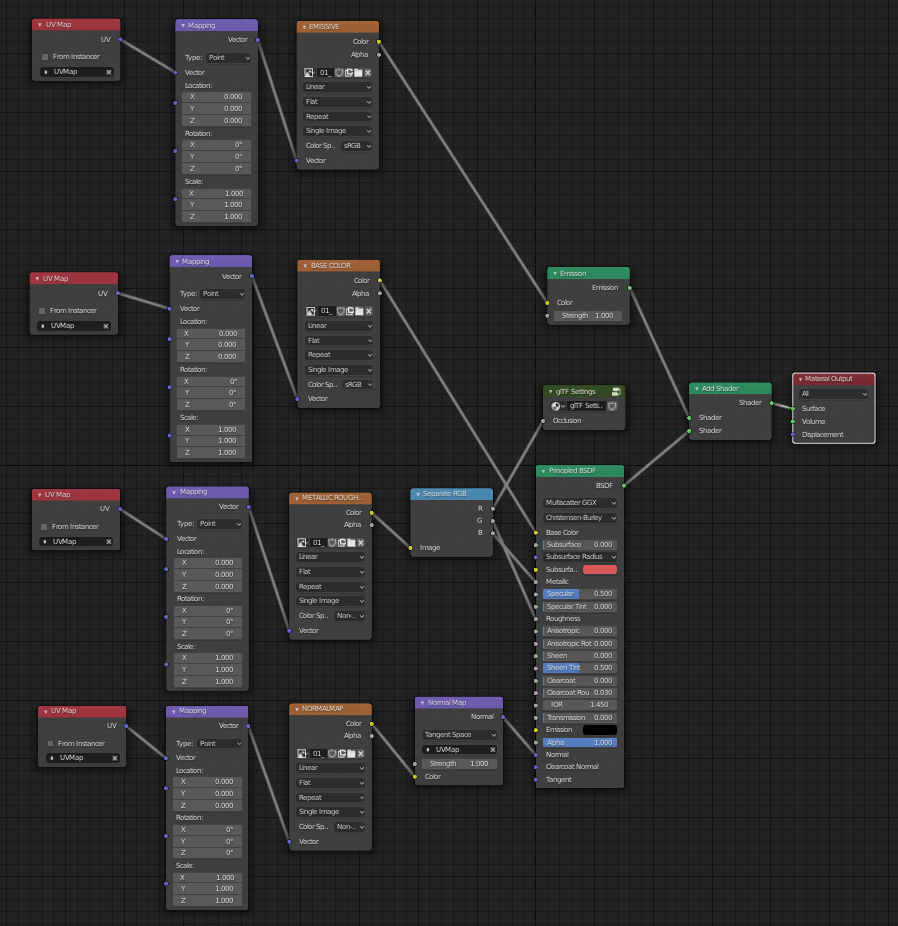glTF 2.0¶
Reference
- Category
Import-Export
- Menu
Usage¶
glTF™ (GL Transmission Format) is used for transmission and loading of 3D models in web and native applications. glTF reduces the size of 3D models and the runtime processing needed to unpack and render those models. This format is commonly used on the web, and has support in various 3D engines such as Unity3D, Unreal Engine 4, and Godot.
This importer/exporter supports the following glTF 2.0 features:
Meshes
Materials (Principled BSDF) and Shadeless (Unlit)
Textures
Cameras
Punctual lights (point, spot, and directional)
Animation (keyframe, shape key, and skinning)
Meshes¶
glTF's internal structure mimics the memory buffers commonly used by graphics chips when rendering in real-time, such that assets can be delivered to desktop, web, or mobile clients and be promptly displayed with minimal processing. As a result, quads and n-gons are automatically converted to triangles when exporting to glTF. Discontinuous UVs and flat-shaded edges may result in moderately higher vertex counts in glTF compared to Blender, as such vertices are separated for export. Likewise, curves and other non-mesh data are not preserved, and must be converted to meshes prior to export.
Materials¶
The core material system in glTF supports a metal/rough PBR workflow with the following channels of information:
Base Color
Metallic
Roughness
Baked Ambient Occlusion
Normal Map
Emissive
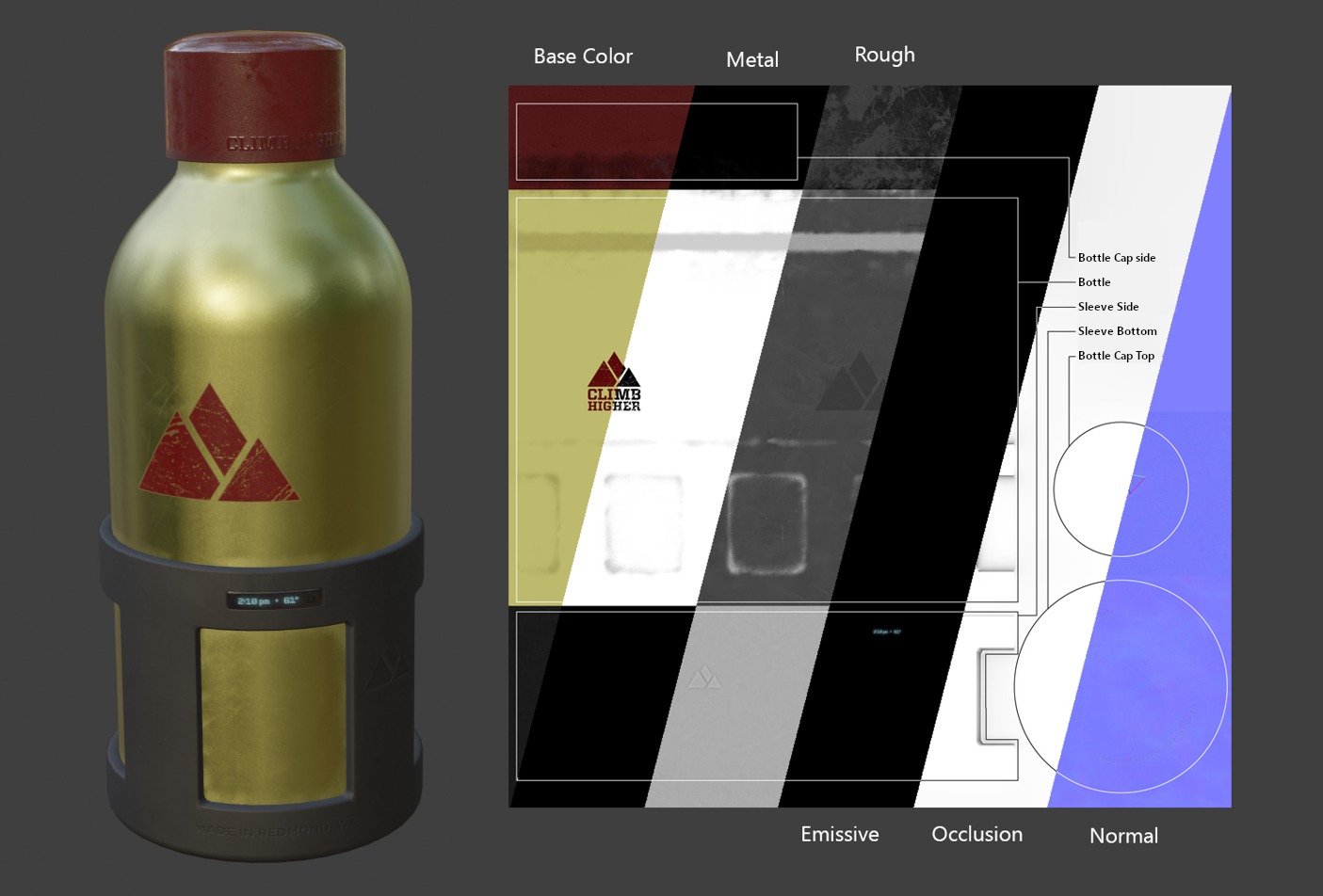
An example of the various image maps available in the glTF 2.0 core format. This is the water bottle sample model shown alongside slices of its various image maps.¶
Imported Materials¶
The glTF material system is different from Blender's own materials. When a glTF file is imported, the add-on will construct a set of Blender nodes to replicate each glTF material as closely as possible.
The importer supports Metal/Rough PBR (core glTF), Spec/Gloss PBR (KHR_materials_pbrSpecularGlossiness)
and Shadeless (KHR_materials_unlit) materials.
ちなみに
Examining the result of the material import process is a good way to see examples of the types of material nodes and settings that can be exported to glTF.
Exported Materials¶
The exporter supports Metal/Rough PBR (core glTF) and Shadeless (KHR_materials_unlit) materials.
It will construct a glTF material based on the nodes it recognizes in the Blender material.
The material export process handles the settings described below.
注釈
When image textures are used by materials, glTF requires that images be in PNG or JPEG format. The add-on will automatically convert images from other formats, increasing export time.
ちなみに
To create Shadeless (Unlit) materials, use the Background material type.
Base Color¶
The glTF base color is determined by looking for a Base Color input on a Principled BSDF node. If the input is unconnected, the input's default color (the color field next to the unconnected socket) is used as the Base Color for the glTF material.

A solid base color can be specified directly on the node.¶
If an Image Texture node is found to be connected to the Base Color input, that image will be used as the glTF base color.

An image is used as the glTF base color.¶
Metallic and Roughness¶
These values are read from the Principled BSDF node. If both of these inputs are unconnected, the node will display sliders to control their respective values between 0.0 and 1.0, and these values will be copied into the glTF.
When using an image, glTF expects the metallic values to be encoded in the blue (B) channel,
and roughness to be encoded in the green (G) channel of the same image.
If images are connected to the Blender node in a manner that does not follow this convention,
the add-on may attempt to adapt the image to the correct form during exporting (with an increased export time).
In the Blender node tree, it is recommended to use a Separate RGB node
to separate the channels from an Image Texture node, and
connect the green (G) channel to Roughness, and blue (B) to Metallic.
The glTF exporter will recognize this arrangement as matching the glTF standard, and
that will allow it to simply copy the image texture into the glTF file during export.
The Image Texture node for this should have its Color Space set to Non-Color.

A metallic/roughness image connected in a manner consistent with the glTF standard, allowing it to be used verbatim inside an exported glTF file.¶
Baked Ambient Occlusion¶
glTF is capable of storing a baked ambient occlusion map.
Currently there is no arrangement of nodes that causes Blender
to use such a map in exactly the same way as intended in glTF.
However, if the exporter finds a custom node group by the name of glTF Settings, and
finds an input named Occlusion on that node group,
it will look for an Image Texture attached there to use as the occlusion map in glTF.
The effect need not be shown in Blender, as Blender has other ways of showing ambient occlusion,
but this method will allow the exporter to write an occlusion image to the glTF.
This can be useful to real-time glTF viewers, particularly on platforms where there
may not be spare power for computing such things at render time.
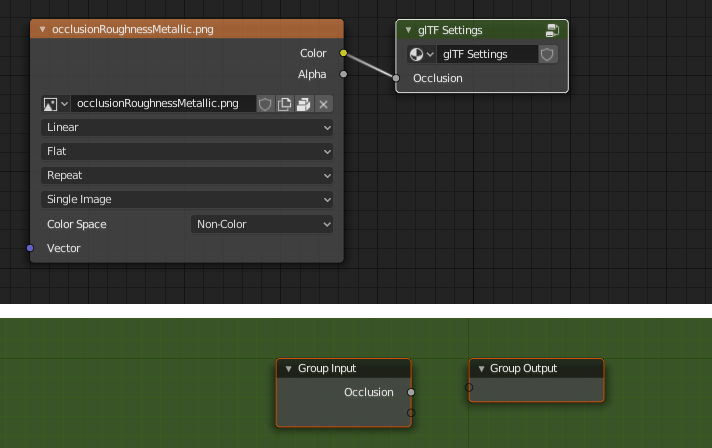
A pre-baked ambient occlusion map, connected to a node that doesn't render but will export to glTF.¶
ちなみに
The easiest way to create the custom node group is to import an existing glTF model that contains an occlusion map, such as the water bottle or another existing model. A manually created custom node group can also be used.
glTF stores occlusion in the red (R) channel, allowing it to optionally share
the same image with the roughness and metallic channels.
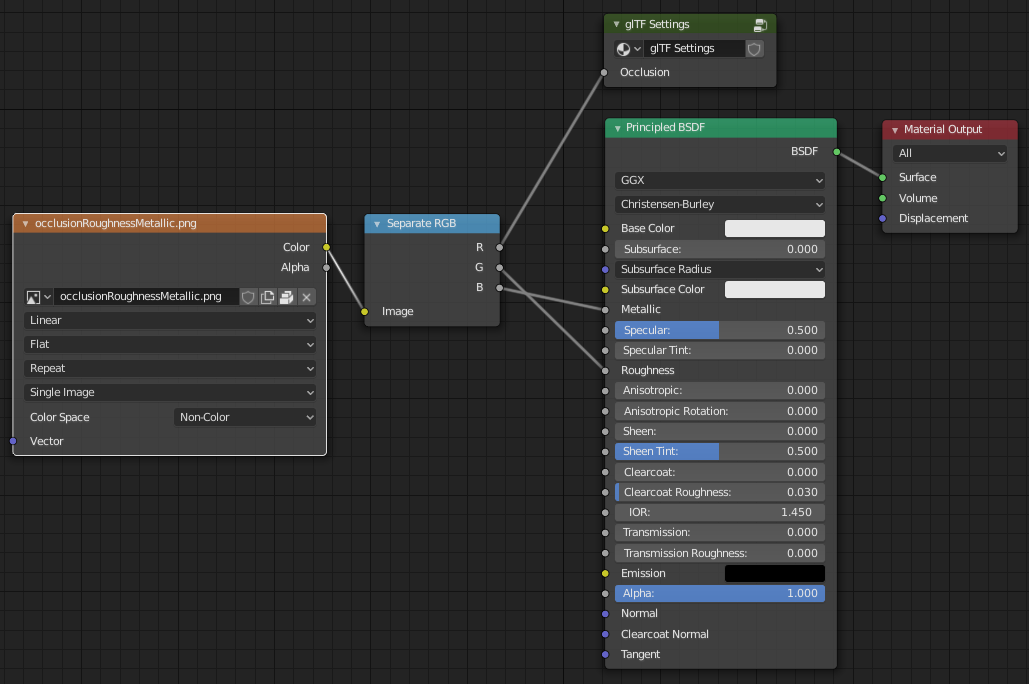
This combination of nodes mimics the way glTF packs occlusion, roughness, and metallic values into a single image.¶
ちなみに
The Cycles render engine has a Bake panel that can be used to bake
ambient occlusion maps. The resulting image can be saved and connected
directly to the glTF Settings node.
Normal Map¶
To use a normal map in glTF, connect an Image Texture node's color output to a Normal Map node's color input, and then connect the Normal Map normal output to the Principled BSDF node's normal input. The Image Texture node for this should have its Color Space property set to Non-Color.
The Normal Map node must remain on its default property of Tangent Space as this is the only type of normal map currently supported by glTF. The strength of the normal map can be adjusted on this node. The exporter is not exporting these nodes directly, but will use them to locate the correct image and will copy the strength setting into the glTF.
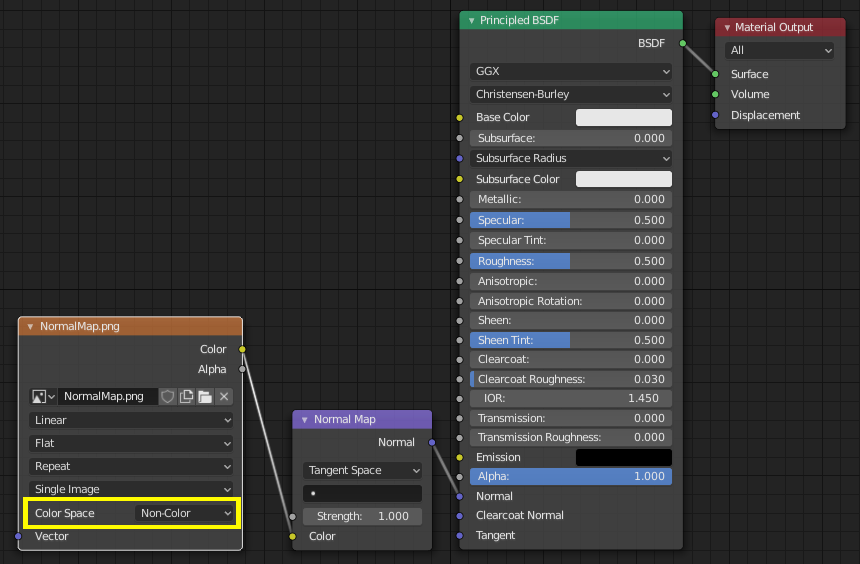
A normal map image connected such that the exporter will find it and copy it to the glTF file.¶
ちなみに
The Cycles render engine has a Bake panel that can be used to bake tangent-space normal maps from almost any other arrangement of normal vector nodes. Switch the Bake type to Normal. Keep the default space settings (space: Tangent, R: +X, G: +Y, B: +Z) when using this bake panel for glTF. The resulting baked image can be saved and plugged into to a new material using the Normal Map node as described above, allowing it to export correctly.
See: Cycles Render Baking
Emissive¶
An Image Texture node can be connected to the Emission input on the Principled BSDF node to include an emissive map with the glTF material. Alternatively, the Image Texture node can be connected to an Emission shader node, and optionally combined with properties from a Principled BSDF node by way of an Add Shader node.
If the emissive map is alone in the material, it is best to set the Base Color default to black, and the Roughness default to 1.0. This minimizes the influence of the other channels if they are not needed.

This arrangement is supported for backwards compatibility. It is simpler to use the Principled BSDF node directly.¶
Double-Sided / Backface Culling¶
For materials where only the front faces will be visible, turn on Backface Culling in the Settings panel of an Eevee material. When using other engines (Cycles, Workbench) you can temporarily switch to Eevee to configure this setting, then switch back.
Leave this box un-checked for double-sided materials.
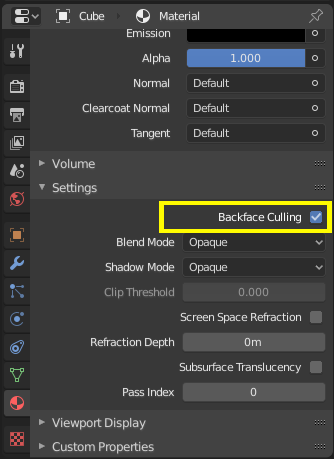
The inverse of this setting controls glTF's DoubleSided flag.¶
Blend Modes¶
The Base Color input can optionally supply alpha values. How these values are treated by glTF depends on the selected blend mode.
With the Eevee render engine selected, each material has a Blend Mode on the material settings panel. Use this setting to define how alpha values from the Base Color channel are treated in glTF. Three settings are supported by glTF:
- Opaque
Alpha values are ignored.
- Alpha Blend
Lower alpha values cause blending with background objects.
- Alpha Clip
Alpha values below the Clip Threshold setting will cause portions of the material to not be rendered at all. Everything else is rendered as opaque.
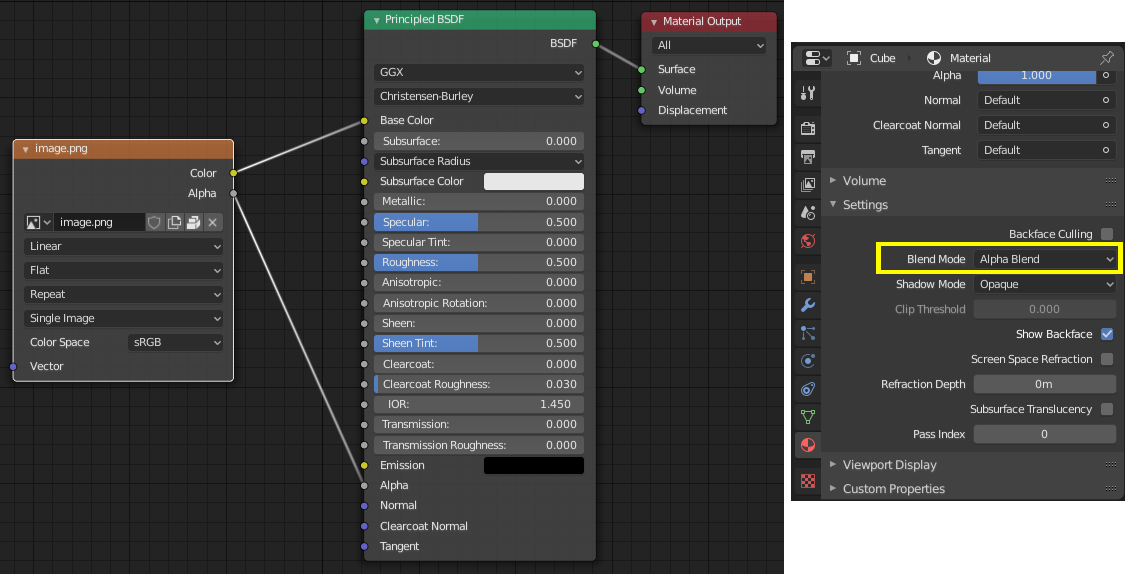
With the Eevee engine selected, a material's blend modes are configurable.¶
注釈
Be aware that transparency (or Alpha Blend mode) is complex for real-time engines to render, and may behave in unexpected ways after export. Where possible, use Alpha Clip mode instead, or place Opaque polygons behind only a single layer of Alpha Blend polygons.
UV Mapping¶
Control over UV map selection and transformations is available by connecting a UV Map node and a Mapping node to any Image Texture node.
Settings from the Mapping node are exported using a glTF extension named KHR_texture_transform.
There is a mapping type selector across the top. Point is the recommended type for export.
Texture and Vector are also supported. The supported offsets are:
Location - X and Y
Rotation - Z only
Scale - X and Y
For the Texture type, Scale X and Y must be equal (uniform scaling).
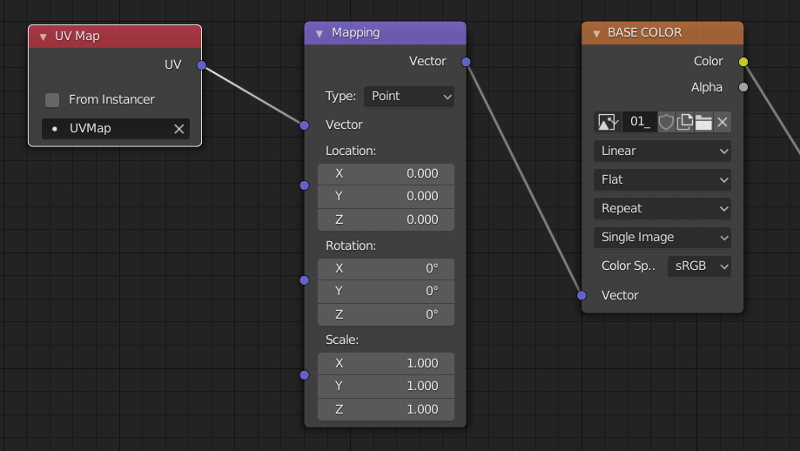
A deliberate choice of UV mapping.¶
ちなみに
These nodes are optional. Not all glTF readers support multiple UV maps or texture transforms.
Factors¶
Any Image Texture nodes may optionally be multiplied with a constant color or scalar. These will be written as factors in the glTF file, which are numbers that are multiplied with the specified image textures. These are not common.
Extensions¶
The core glTF 2.0 format can be extended with extra information, using glTF extensions. This allows the file format to hold details that were not considered universal at the time of first publication. Not all glTF readers support all extensions, but some are fairly common.
Certain Blender features can only be exported to glTF via these extensions. The following glTF 2.0 extensions are supported directly by this add-on:
Import
KHR_materials_pbrSpecularGlossinessKHR_lights_punctualKHR_materials_unlitKHR_texture_transform
Export
KHR_draco_mesh_compressionKHR_lights_punctualKHR_materials_unlitKHR_texture_transform
Animation¶
glTF allows multiple animations per file, with animations targeted to particular objects at time of export. To ensure that an animation is included, either (a) make it the active Action on the object, (b) create a single-strip NLA track, or (c) stash the action.
Supported
Only certain types of animation are supported:
Keyframe (translation, rotation, scale)
Shape keys
Armatures / skinning
Animation of other properties, like lights or materials, will be ignored.
An NLA Strip animation consists of multiple actions on multiple objects that should play together. To create an NLA strip animation with the name "My Animation", push the action that should play each object onto an NLA track for that object with the name "My Animation".
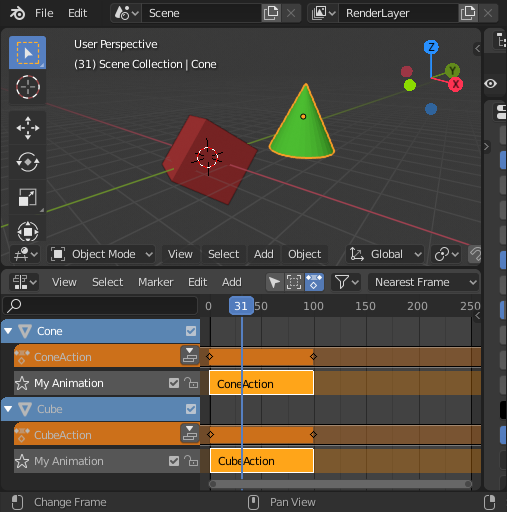
Will be exported as an animation called "My Animation" with ConeAction playing on the Cone and CubeAction playing on the Cube.¶
NLA Strip animations will be exported if the option is selected (on by default). All glTF animations are imported as NLA Strip animations.
If option is disabled, Blender NLA strip actions will be ignored. Only active action of each objects will be taken into account, and merged into a single glTF animation.
Custom Properties¶
Custom properties on most objects are preserved in glTF export/import, and may be used for user-specific purposes.
File Format Variations¶
The glTF specification identifies different ways the data can be stored. The importer handles all of these ways. The exporter will ask the user to select one of the following forms:
glTF Binary (.glb)¶
This produces a single .glb file with all mesh data, image textures, and
related information packed into a single binary file.
ちなみに
Using a single file makes it easy to share or copy the model to other systems and services.
glTF Separate (.gltf + .bin + textures)¶
This produces a JSON text-based .gltf file describing the overall structure,
along with a .bin file containing mesh and vector data, and
optionally a number of .png or .jpg files containing image textures
referenced by the .gltf file.
ちなみに
Having an assortment of separate files makes it much easier for a user to go back and edit any JSON or images after the export has completed.
注釈
Be aware that sharing this format requires sharing all of these separate files together as a group.
glTF Embedded (.gltf)¶
This produces a JSON text-based .gltf file, with all mesh data and
image data encoded (using Base64) within the file. This form is useful if
the asset must be shared over a plain-text-only connection.
警告
This is the least efficient of the available forms, and should only be used when required.
Properties¶
Import¶
- Pack Images
Pack all images into the blend-file.
- Shading
How normals are computed during import.
Export¶
- Format
See: File Format Variations.
- Textures
Folder to place texture files in. Relative to the gltf-file.
- Copyright
Legal rights and conditions for the model.
- Remember Export Settings
Store export settings in the blend-file, so they will be recalled next time the file is opened.
Include¶
- Selected Objects
Export selected objects only.
- Custom Properties
Export custom properties as glTF extras.
- Cameras
Export cameras.
- Punctual Lights
Export directional, point, and spot lights. Uses the
KHR_lights_punctualglTF extension.
Transform¶
- Y Up
Export using glTF convention, +Y up.
Geometry¶
- Apply Modifiers
Apply modifiers (excluding armatures) to mesh objects.
- UVs
Export UVs (texture coordinates) with meshes.
- Normals
Export vertex normals with meshes.
- Tangents
Export vertex tangents with meshes.
- Vertex Colors
Export vertex colors with meshes.
- Materials
Export materials.
- Images
Output format for images. PNG is lossless and generally preferred, but JPEG might be preferable for web applications due to the smaller file size.
Compression¶
Compress meshes using Google Draco.
- Compression Level
Higher compression results in slower encoding and decoding.
- Quantization Position
Higher values result in better compression rates.
- Normal
Higher values result in better compression rates.
- Texture Coordinates
Higher values result in better compression rates.
- Generic
Higher values result in better compression rates.
Animation¶
- Use Current Frame
Export the scene in the current animation frame.
Animation¶
Exports active actions and NLA tracks as glTF animations.
- Limit to Playback Range
Clips animations to selected playback range.
- Sampling Rate
How often to evaluate animated values (in frames).
- Always Sample Animations
Apply sampling to all animations.
- NLA Strips
Whether to export NLA strip animations.
- Export Deformation Bones Only
Export deformation bones only (and needed bones for hierarchy).
Shape Keys¶
Export shape keys (morph targets).
- Shape Key Normals
Export vertex normals with shape keys (morph targets).
- Shape Key Tangents
Export vertex tangents with shape keys (morph targets).
Skinning¶
Export skinning (armature) data.
- Include All Bone Influences
Allow less than 4 joint vertex influences. Models may appear incorrectly in many viewers.
Contributing¶
This importer/exporter is developed through the glTF-Blender-IO repository, where you can file bug reports, submit feature requests, or contribute code.
Discussion and development of the glTF 2.0 format itself takes place on the Khronos Group glTF Github repository, and feedback there is welcome.
